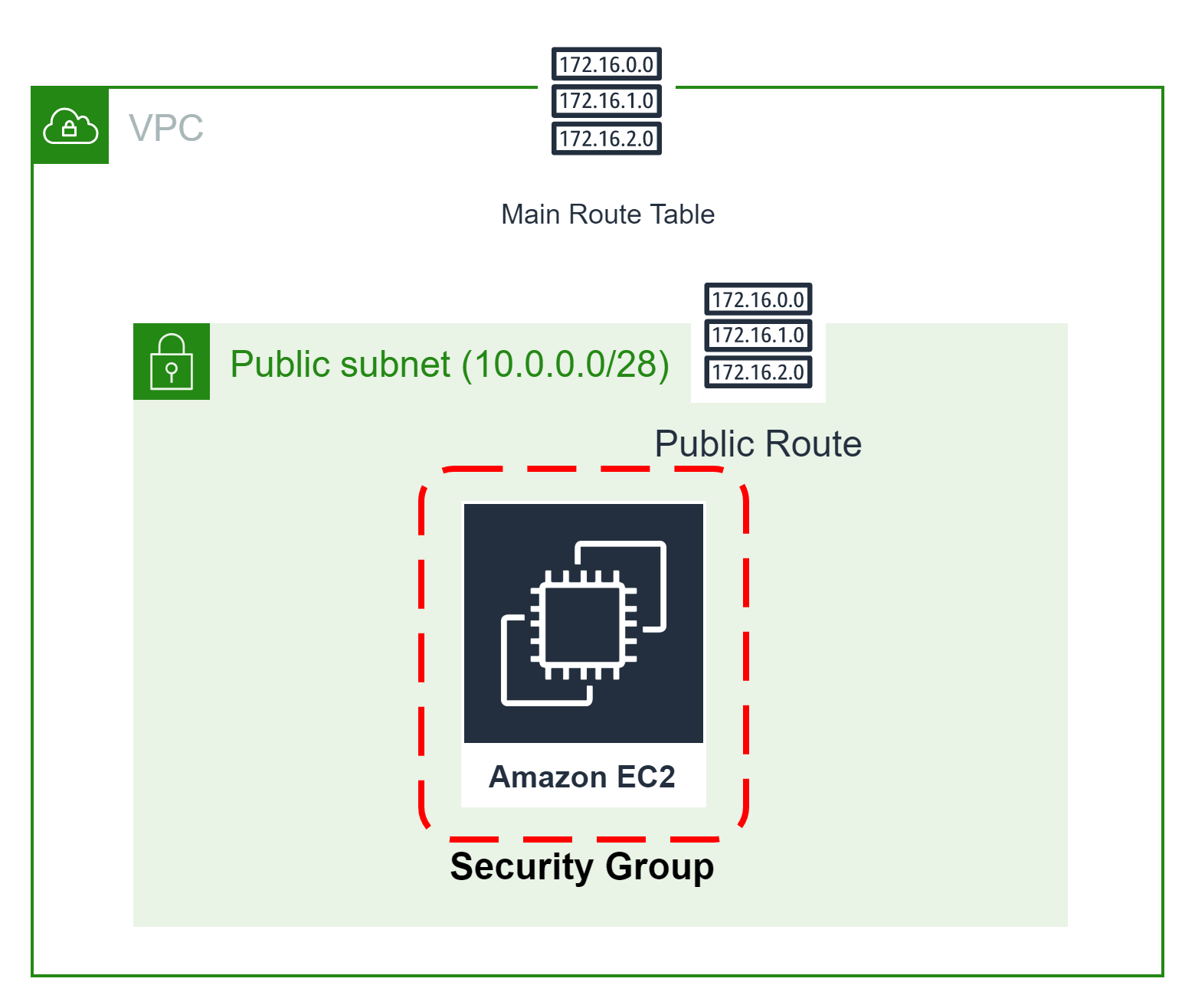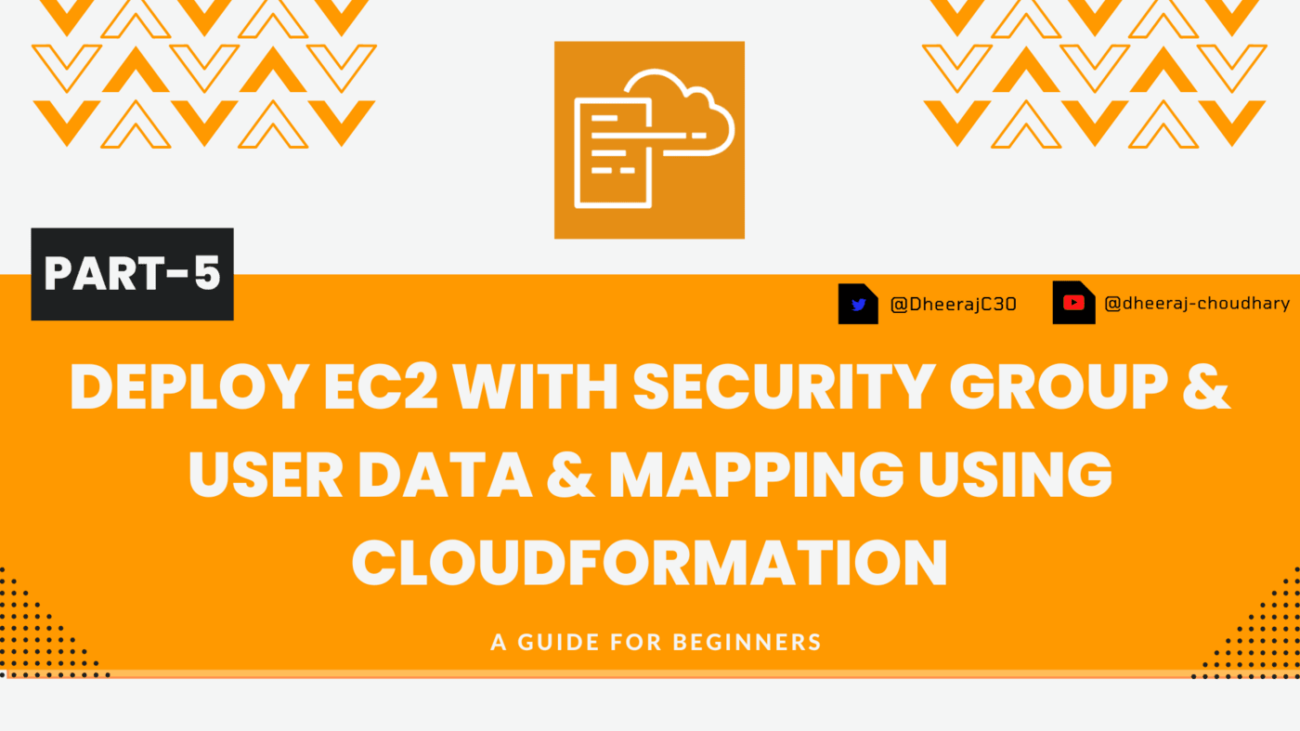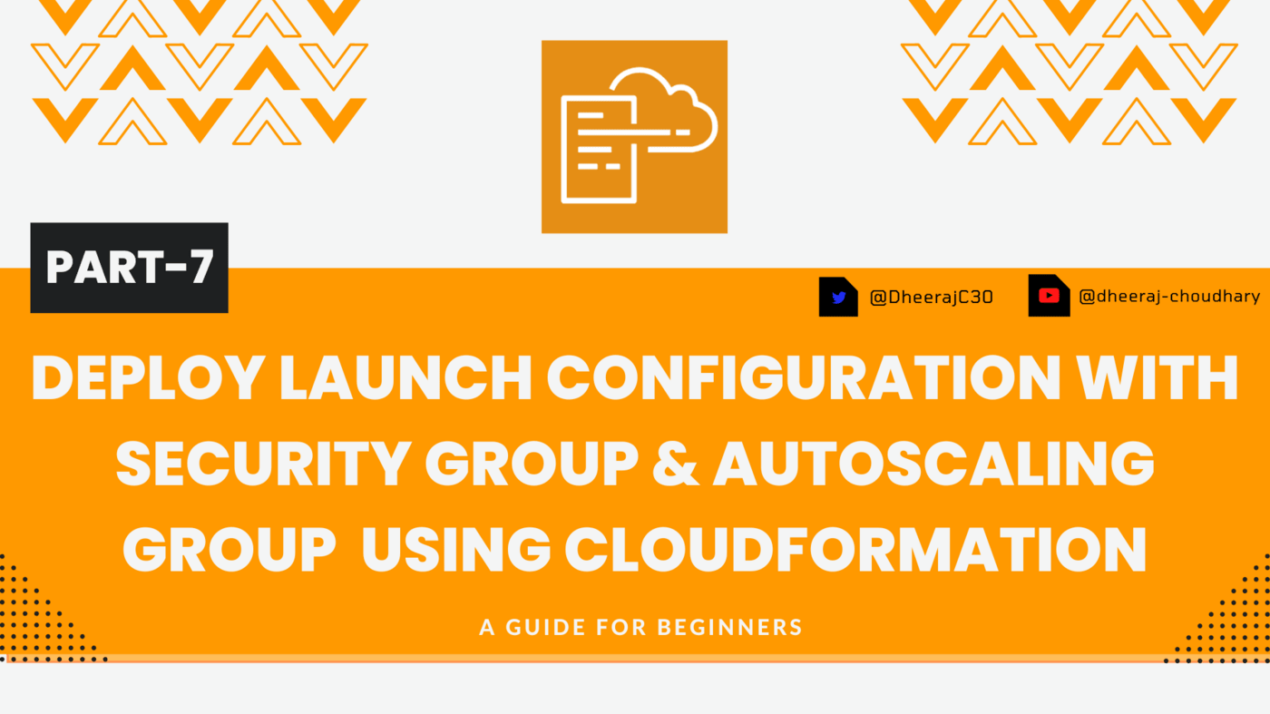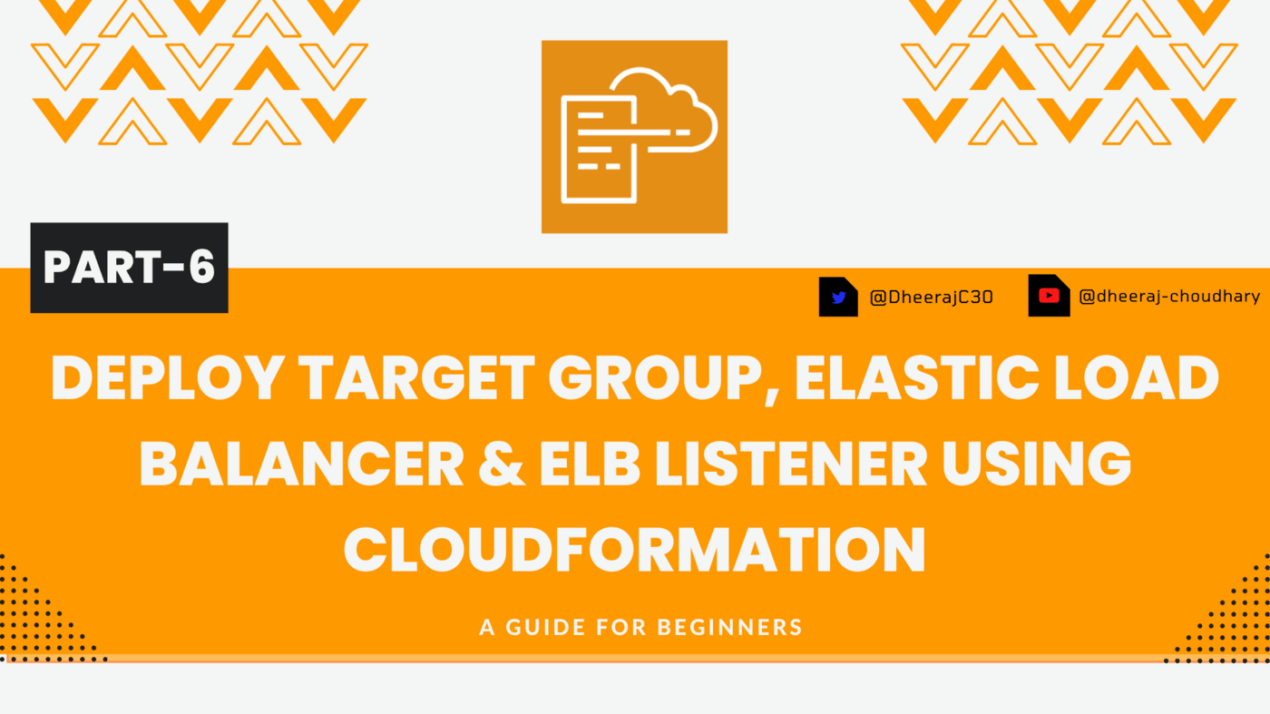Welcome back to the series of AWS Cloudformation For Beginners 👨🏻💻. In this blog I have covered 3 usecases in which we will create
✦ Ubuntu EC2 instance with security group.
✦ Ubuntu EC2 instance with Security group & Userdata.
✦ Ubuntu EC2 instance with Security group & Mappings.
If you are a beginner and want to start your journey towards infra-as-code developer as part of your devops role buckle up 🚴♂️ and lets get started and understand core cloudformation concepts by implementing it…🎬
🎨 Diagrammatic Representation 🎨

🌟Launch EC2 Instance With Security Group🌟
🔳 Resources
✦ UbuntuInstance:- As part of this resource we use type “AWS::EC2::Instance”.
➖ ImageId:- This property is used to mention EC2 image ID based on which you want to launch your EC2 Instance.
➖ KeyName:- This property is used to mention keynameby using which you can connect to your EC2 instance.
➖ InstanceType:- This property is used to mention which type of instance you want to launch smal/medium/large based on your requirement.
➖ SecurityGroupIds:- This property is used to add list of security group you want to attach to your EC2 instance for enabling access control based on your security requirements.
➖ Tags:- One of the most important property used in all resources. Always make sure to attach tags for all your resources.
✦ InstanceSecurityGroup:- Creating Security group and enabling ingress with http and ssh port.
➖ GroupName:- This property is used to mention security group name.
➖ GroupDescription:- This property is used to mention security group description and its mandatory property for this resource.
➖ SecurityGroupIngress:- This property is used to add ingress rules for [udp/tcp] ports enabled secured access to your resources.
➖ Tags:- One of the most important property used in all resources. Alaways make sure to attach tags for all your resources.
🔳 Outputs: Its always a best practice to print output for your resources.
✦ outputmyUbuntuInstance: A reference to the created EC2 Instance.
✦ outputInstanceSecurityGroup:- A reference to the created Security Group
Resources:
InstanceSecurityGroup:
Type: AWS::EC2::SecurityGroup
Properties:
GroupName: AllowEC2Traffic
GroupDescription: Enable SSH access and HTTP access on the inbound port
SecurityGroupIngress:
- IpProtocol: tcp
FromPort: 80
ToPort: 80
CidrIp: 0.0.0.0/0
- IpProtocol: tcp
FromPort: 22
ToPort: 22
CidrIp: 0.0.0.0/0
Tags:
- Key: Name
Value: InstanceSecurityGroup
UbuntuInstance:
Type: AWS::EC2::Instance
Properties:
KeyName: "<Key Name>"
ImageId: "ami-04505e74c0741db8d"
InstanceType: <Instance Type>
SecurityGroupIds:
- !GetAtt "InstanceSecurityGroup.GroupId"
Tags:
- Key: Name
Value: UbuntuInstance
Outputs:
outputInstanceSecurityGroup:
Description: A reference to the created security group
Value: !Ref InstanceSecurityGroup
outputUbuntuInstance:
Description: A reference to the created EC2 Instance
Value: !Ref UbuntuInstance
To view entire github code click here
1️⃣ Lets validate our template 👨💻
aws cloudformation validate-template --template-body file://<file path>
2️⃣ After successful template verification lets create stack using our template 👨💻
aws cloudformation create-stack --stack-name ec2 --template-body file://<file path>
3️⃣ Check if the stack we created via template is completed successfully 👨💻
aws cloudformation list-stack-resources --stack-name ec2
4️⃣ Describe stack and its resources to view its properties 👨💻
aws cloudformation describe-stacks --stack-name ec2
aws cloudformation describe-stack-resources --stack-name ec2
5️⃣ Check events for stack formation 👨💻
aws cloudformation describe-stack-events --stack-name ec2
👁🗨👁🗨 YouTube Tutorial 📽
🌟Launch EC2 Instance With Security Group & Userdata🌟
🔳 Resources
✦ UbuntuInstance:- As part of this resource we use type “AWS::EC2::Instance”.
➖ ImageId:- This property is used to mention EC2 image ID based on which you want to launch your EC2 Instance.
➖ KeyName:- This property is used to mention keynameby using which you can connect to your EC2 instance.
➖ InstanceType:- This property is used to mention which type of instance you want to launch smal/medium/large based on your requirement.
➖ SecurityGroupIds:- This property is used to add list of security group you want to attach to your EC2 instance for enabling access control based on your security requirements.
➖ Tags:- One of the most important property used in all resources. Always make sure to attach tags for all your resources.
➖ User Data: User data is user data/commands that you can specify at the time of launching your instance. These data/command executes after your EC2 instance starts. You don’t need to SSH into your EC2 instance and run those command one by one. Rather all you need is to specify the whole script in the user data section and they get executed once your instance boots up. You can use AWS CloudFormation to automatically install, configure, and start applications on Amazon EC2 instances. Doing so enables you to easily replicate deployments and update existing installations without connecting directly to the instance, which can save you a lot of time and effort. ✦ InstanceSecurityGroup:- Creating Security group and enabling ingress with http and ssh port.
➖ GroupName:- This property is used to mention security group name.
➖ GroupDescription:- This property is used to mention security group description and its mandatory property for this resource.
➖ SecurityGroupIngress:- This property is used to add ingress rules for [udp/tcp] ports enabled secured access to your resources.
➖ Tags:- One of the most important property used in all resources. Always make sure to attach tags for all your resources.
🔳 Outputs: Its always a best practice to print output for your resources.
✦ outputmyUbuntuInstance: A reference to the created EC2 Instance.
✦ outputInstanceSecurityGroup:- A reference to the created Security Group
Resources:
InstanceSecurityGroup:
Type: AWS::EC2::SecurityGroup
Properties:
GroupDescription: Enable SSH access and HTTP access on the inbound port
GroupName: AllowAllTraffic
SecurityGroupIngress:
- IpProtocol: tcp
FromPort: 80
ToPort: 80
CidrIp: 0.0.0.0/0
- IpProtocol: tcp
FromPort: 22
ToPort: 22
CidrIp: 0.0.0.0/0
UbuntuInstance:
Type: 'AWS::EC2::Instance'
Properties:
ImageId: "ami-04505e74c0741db8d"
InstanceType: t2.micro
KeyName: <Add your keyname>
Tags:
- Key: Name
Value: "Ubuntu"
SecurityGroupIds: !Ref InstanceSecurityGroup
UserData:
Fn::Base64:
!Sub |
#!/bin/bash
sudo apt-get update -y
sudo apt-get install -y apache2
sudo ufw allow -y 'Apache'
sudo systemctl start apache2
sudo systemctl enable apache2
echo Hello World from $(hostname -f) > /var/www/html/index.html
Outputs:
outputInstanceSecurityGroup:
Description: A reference to the created security group
Value: !Ref InstanceSecurityGroup
outputUbuntuInstance:
Description: A reference to the created EC2 Instance
Value: !Ref UbuntuInstance
To view entire github code click here
1️⃣ Lets validate our template 👨💻
aws cloudformation validate-template --template-body file://<file path>
2️⃣ After successful template verification lets create stack using our template 👨💻
aws cloudformation create-stack --stack-name ec2withuserdata --template-body file://<file path>
3️⃣ Check if the stack we created via template is completed successfully 👨💻
aws cloudformation list-stack-resources --stack-name ec2withuserdata
4️⃣ Describe stack and its resources to view its properties 👨💻
aws cloudformation describe-stacks --stack-name ec2withuserdata
aws cloudformation describe-stack-resources --stack-name ec2withuserdata
5️⃣ Check events for stack formation 👨💻
aws cloudformation describe-stack-events --stack-name ec2withuserdata
👁🗨👁🗨 YouTube Tutorial 📽
🌟Launch EC2 Instance With Security Group, Mappings & Parameters🌟
🔳 Parameters
✦ InstanceType :- Using this parameter we are going to provide list of instance type so that preferred instance type can be selected from the list.
🔳 Mappings:- The optional Mappings section matches a key to a corresponding set of named values. For example, if you want to set values based on a region, you can create a mapping that uses the region name as a key and contains the values you want to specify for each specific region. You use the Fn::FindInMap intrinsic function to retrieve values in a map.
➖ AWSInstanceType2Arch
➖ AWSInstanceType2NATArch
➖ AWSRegionArch2AMI
🔳 Resources
✦ UbuntuInstance:- As part of this resource we use type “AWS::EC2::Instance”.
➖ ImageId:- This property is used to mention EC2 image ID based on which you want to launch your EC2 Instance.
➖ KeyName:- This property is used to mention keynameby using which you can connect to your EC2 instance.
➖ InstanceType:- This property is used to mention which type of instance you want to launch smal/medium/large based on your requirement.
➖ SecurityGroupIds:- This property is used to add list of security group you want to attach to your EC2 instance for enabling access control based on your security requirements.
➖ Tags:- One of the most important property used in all resources. Always make sure to attach tags for all your resources.
➖ User Data: User data is user data/commands that you can specify at the time of launching your instance. These data/command executes after your EC2 instance starts. You don’t need to SSH into your EC2 instance and run those command one by one. Rather all you need is to specify the whole script in the user data section and they get executed once your instance boots up. You can use AWS CloudFormation to automatically install, configure, and start applications on Amazon EC2 instances. Doing so enables you to easily replicate deployments and update existing installations without connecting directly to the instance, which can save you a lot of time and effort. ✦ InstanceSecurityGroup:- Creating Security group and enabling ingress with http and ssh port.
➖ GroupName:- This property is used to mention security group name.
➖ GroupDescription:- This property is used to mention security group description and its mandatory property for this resource.
➖ SecurityGroupIngress:- This property is used to add ingress rules for [udp/tcp] ports enabled secured access to your resources.
➖ Tags:- One of the most important property used in all resources. Always make sure to attach tags for all your resources.
🔳 Outputs: Its always a best practice to print output for your resources.
✦ outputmyUbuntuInstance: A reference to the created EC2 Instance.
✦ outputInstanceSecurityGroup:- A reference to the created Security Group
✦ InstanceId:- InstanceId of the newly created EC2 instance.
✦ AZ :- Availability Zone of the newly created EC2 instance.
✦ PublicDNS:- Public DNSName of the newly created EC2 instance.
✦ PublicIP:- Public IP address of the newly created EC2 instance.
Parameters:
InstanceType:
Description: WebServer EC2 instance type
Type: String
Default: t2.small
AllowedValues:
- t1.micro
- t2.nano
- t2.micro
- t2.small
- t2.medium
- t2.large
- m1.small
- m1.medium
- m1.large
- m1.xlarge
- m2.xlarge
- m2.2xlarge
- m2.4xlarge
- m3.medium
- m3.large
- m3.xlarge
- m3.2xlarge
- m4.large
- m4.xlarge
- m4.2xlarge
- m4.4xlarge
- m4.10xlarge
- c1.medium
- c1.xlarge
- c3.large
- c3.xlarge
- c3.2xlarge
- c3.4xlarge
- c3.8xlarge
- c4.large
- c4.xlarge
- c4.2xlarge
- c4.4xlarge
- c4.8xlarge
- g2.2xlarge
- g2.8xlarge
- r3.large
- r3.xlarge
- r3.2xlarge
- r3.4xlarge
- r3.8xlarge
- i2.xlarge
- i2.2xlarge
- i2.4xlarge
- i2.8xlarge
- d2.xlarge
- d2.2xlarge
- d2.4xlarge
- d2.8xlarge
- hi1.4xlarge
- hs1.8xlarge
- cr1.8xlarge
- cc2.8xlarge
- cg1.4xlarge
ConstraintDescription: must be a valid EC2 instance type.
Mappings:
AWSInstanceType2Arch:
t1.micro:
Arch: HVM64
t2.nano:
Arch: HVM64
t2.micro:
Arch: HVM64
t2.small:
Arch: HVM64
t2.medium:
Arch: HVM64
t2.large:
Arch: HVM64
m1.small:
Arch: HVM64
m1.medium:
Arch: HVM64
m1.large:
Arch: HVM64
m1.xlarge:
Arch: HVM64
m2.xlarge:
Arch: HVM64
m2.2xlarge:
Arch: HVM64
m2.4xlarge:
Arch: HVM64
m3.medium:
Arch: HVM64
m3.large:
Arch: HVM64
m3.xlarge:
Arch: HVM64
m3.2xlarge:
Arch: HVM64
m4.large:
Arch: HVM64
m4.xlarge:
Arch: HVM64
m4.2xlarge:
Arch: HVM64
m4.4xlarge:
Arch: HVM64
m4.10xlarge:
Arch: HVM64
c1.medium:
Arch: HVM64
c1.xlarge:
Arch: HVM64
c3.large:
Arch: HVM64
c3.xlarge:
Arch: HVM64
c3.2xlarge:
Arch: HVM64
c3.4xlarge:
Arch: HVM64
c3.8xlarge:
Arch: HVM64
c4.large:
Arch: HVM64
c4.xlarge:
Arch: HVM64
c4.2xlarge:
Arch: HVM64
c4.4xlarge:
Arch: HVM64
c4.8xlarge:
Arch: HVM64
g2.2xlarge:
Arch: HVMG2
g2.8xlarge:
Arch: HVMG2
r3.large:
Arch: HVM64
r3.xlarge:
Arch: HVM64
r3.2xlarge:
Arch: HVM64
r3.4xlarge:
Arch: HVM64
r3.8xlarge:
Arch: HVM64
i2.xlarge:
Arch: HVM64
i2.2xlarge:
Arch: HVM64
i2.4xlarge:
Arch: HVM64
i2.8xlarge:
Arch: HVM64
d2.xlarge:
Arch: HVM64
d2.2xlarge:
Arch: HVM64
d2.4xlarge:
Arch: HVM64
d2.8xlarge:
Arch: HVM64
hi1.4xlarge:
Arch: HVM64
hs1.8xlarge:
Arch: HVM64
cr1.8xlarge:
Arch: HVM64
cc2.8xlarge:
Arch: HVM64
AWSInstanceType2NATArch:
t1.micro:
Arch: NATHVM64
t2.nano:
Arch: NATHVM64
t2.micro:
Arch: NATHVM64
t2.small:
Arch: NATHVM64
t2.medium:
Arch: NATHVM64
t2.large:
Arch: NATHVM64
m1.small:
Arch: NATHVM64
m1.medium:
Arch: NATHVM64
m1.large:
Arch: NATHVM64
m1.xlarge:
Arch: NATHVM64
m2.xlarge:
Arch: NATHVM64
m2.2xlarge:
Arch: NATHVM64
m2.4xlarge:
Arch: NATHVM64
m3.medium:
Arch: NATHVM64
m3.large:
Arch: NATHVM64
m3.xlarge:
Arch: NATHVM64
m3.2xlarge:
Arch: NATHVM64
m4.large:
Arch: NATHVM64
m4.xlarge:
Arch: NATHVM64
m4.2xlarge:
Arch: NATHVM64
m4.4xlarge:
Arch: NATHVM64
m4.10xlarge:
Arch: NATHVM64
c1.medium:
Arch: NATHVM64
c1.xlarge:
Arch: NATHVM64
c3.large:
Arch: NATHVM64
c3.xlarge:
Arch: NATHVM64
c3.2xlarge:
Arch: NATHVM64
c3.4xlarge:
Arch: NATHVM64
c3.8xlarge:
Arch: NATHVM64
c4.large:
Arch: NATHVM64
c4.xlarge:
Arch: NATHVM64
c4.2xlarge:
Arch: NATHVM64
c4.4xlarge:
Arch: NATHVM64
c4.8xlarge:
Arch: NATHVM64
g2.2xlarge:
Arch: NATHVMG2
g2.8xlarge:
Arch: NATHVMG2
r3.large:
Arch: NATHVM64
r3.xlarge:
Arch: NATHVM64
r3.2xlarge:
Arch: NATHVM64
r3.4xlarge:
Arch: NATHVM64
r3.8xlarge:
Arch: NATHVM64
i2.xlarge:
Arch: NATHVM64
i2.2xlarge:
Arch: NATHVM64
i2.4xlarge:
Arch: NATHVM64
i2.8xlarge:
Arch: NATHVM64
d2.xlarge:
Arch: NATHVM64
d2.2xlarge:
Arch: NATHVM64
d2.4xlarge:
Arch: NATHVM64
d2.8xlarge:
Arch: NATHVM64
hi1.4xlarge:
Arch: NATHVM64
hs1.8xlarge:
Arch: NATHVM64
cr1.8xlarge:
Arch: NATHVM64
cc2.8xlarge:
Arch: NATHVM64
AWSRegionArch2AMI:
af-south-1:
HVM64: ami-064cc455f8a1ef504
HVMG2: NOT_SUPPORTED
ap-east-1:
HVM64: ami-f85b1989
HVMG2: NOT_SUPPORTED
ap-northeast-1:
HVM64: ami-0b2c2a754d5b4da22
HVMG2: ami-09d0e0e099ecabba2
ap-northeast-2:
HVM64: ami-0493ab99920f410fc
HVMG2: NOT_SUPPORTED
ap-northeast-3:
HVM64: ami-01344f6f63a4decc1
HVMG2: NOT_SUPPORTED
ap-south-1:
HVM64: ami-03cfb5e1fb4fac428
HVMG2: ami-0244c1d42815af84a
ap-southeast-1:
HVM64: ami-0ba35dc9caf73d1c7
HVMG2: ami-0e46ce0d6a87dc979
ap-southeast-2:
HVM64: ami-0ae99b503e8694028
HVMG2: ami-0c0ab057a101d8ff2
ca-central-1:
HVM64: ami-0803e21a2ec22f953
HVMG2: NOT_SUPPORTED
cn-north-1:
HVM64: ami-07a3f215cc90c889c
HVMG2: NOT_SUPPORTED
cn-northwest-1:
HVM64: ami-0a3b3b10f714a0ff4
HVMG2: NOT_SUPPORTED
eu-central-1:
HVM64: ami-0474863011a7d1541
HVMG2: ami-0aa1822e3eb913a11
eu-north-1:
HVM64: ami-0de4b8910494dba0f
HVMG2: ami-32d55b4c
eu-south-1:
HVM64: ami-08427144fe9ebdef6
HVMG2: NOT_SUPPORTED
eu-west-1:
HVM64: ami-015232c01a82b847b
HVMG2: ami-0d5299b1c6112c3c7
eu-west-2:
HVM64: ami-0765d48d7e15beb93
HVMG2: NOT_SUPPORTED
eu-west-3:
HVM64: ami-0caf07637eda19d9c
HVMG2: NOT_SUPPORTED
me-south-1:
HVM64: ami-0744743d80915b497
HVMG2: NOT_SUPPORTED
sa-east-1:
HVM64: ami-0a52e8a6018e92bb0
HVMG2: NOT_SUPPORTED
us-east-1:
HVM64: ami-032930428bf1abbff
HVMG2: ami-0aeb704d503081ea6
us-east-2:
HVM64: ami-027cab9a7bf0155df
HVMG2: NOT_SUPPORTED
us-west-1:
HVM64: ami-088c153f74339f34c
HVMG2: ami-0a7fc72dc0e51aa77
us-west-2:
HVM64: ami-01fee56b22f308154
HVMG2: ami-0fe84a5b4563d8f27
Resources:
InstanceSecurityGroup:
Type: AWS::EC2::SecurityGroup
Properties:
GroupDescription: Enable SSH access and HTTP access on the inbound port
GroupName: AllowAllTraffic
SecurityGroupIngress:
- IpProtocol: tcp
FromPort: 80
ToPort: 80
CidrIp: 0.0.0.0/0
- IpProtocol: tcp
FromPort: 22
ToPort: 22
CidrIp: 0.0.0.0/0
EC2Instance:
Type: AWS::EC2::Instance
Properties:
InstanceType: !Ref: InstanceType
SecurityGroups:
KeyName: !Ref KeyName
ImageId:
Fn::FindInMap:
- AWSRegionArch2AMI
- Ref: AWS::Region
- Fn::FindInMap:
- AWSInstanceType2Arch
- Ref: InstanceType
- Arch
Outputs:
outputInstanceSecurityGroup:
Description: A reference to the created security group
Value: !Ref InstanceSecurityGroup
outputInstanceId:
Description: InstanceId of the newly created EC2 instance
Value:
Ref: EC2Instance
outputAZ:
Description: Availability Zone of the newly created EC2 instance
Value:
Fn::GetAtt:
- EC2Instance
- AvailabilityZone
outputPublicDNS:
Description: Public DNSName of the newly created EC2 instance
Value:
Fn::GetAtt:
- EC2Instance
- PublicDnsName
outputPublicIP:
Description: Public IP address of the newly created EC2 instance
Value:
Fn::GetAtt:
- EC2Instance
- PublicIp
To view entire github code click here
1️⃣ Lets validate our template 👨💻
aws cloudformation validate-template --template-body file://<file path>
2️⃣ After successful template verification lets create stack using our template 👨💻
aws cloudformation create-stack --stack-name ec2withmapping --template-body file://<file path>
3️⃣ Check if the stack we created via template is completed successfully 👨💻
aws cloudformation list-stack-resources --stack-name ec2withmapping
4️⃣ Describe stack and its resources to view its properties 👨💻
aws cloudformation describe-stacks --stack-name ec2withmapping
aws cloudformation describe-stack-resources --stack-name ec2withmapping
5️⃣ Check events for stack formation 👨💻
aws cloudformation describe-stack-events --stack-name ec2withmapping❗️❗️Important AWS Documentation To Be Viewed❗️❗️
⛔️ Fn::FindInMap
⛔️ Fn::GetAtt
⛔️ Fn::GetAZs
⛔️ Fn::Base64
⛔️ Mappings
⛔️ Condition functions
⛔️ Outputs
🥁🥁 Conclusion 🥁🥁
In this blog I have covered 3 usecases in which we will create
✦ Ubuntu EC2 instance with security group.
✦ Ubuntu EC2 instance with Security group & Userdata.
✦ Ubuntu EC2 instance with Security group, Userdata & Mappings.
I have used AWS CLI command to deploy these template and trust me AWS CLI is the realtime hero and I would suggest you to get acquainted towards it. Going forward I will be releasing further parts to this CloudFormation journey
📢 Stay tuned for my next blog…..
So, did you find my content helpful? If you did or like my other content, feel free to buy me a coffee. Thanks

Author - Dheeraj Choudhary
RELATED ARTICLES
Deploy AWS Configuration Along With Security Group And AutoScaling Group Using CloudFormation
Welcome back to the series of AWS Cloudformation For Beginners 👨🏻💻. In this blog we create launch configuration along with security grou ...
Deploy AWS Target Group, Elastic Load Balancer & ELB Listener Using CloudFormation
Welcome back to the series of AWS Cloudformation For Beginners 👨🏻💻. In this blog I am going to deploy resources which are very important ...





